Nikada
Originally posted on October 22, 2023
In this weekly market report, we look at the various asset classes, sectors, equity categories, and exchange-traded funds (ETFS) that moved the market higher and the market segments that defied the trend by moving lower. Identifying the winners and losers allows us to see the direction of significant money flows and their origin.
The S&P 500 pullback deepens.
For the week, the S&P 500 was down 2.4%. We are now 7.9% below the 2023 high-water mark, set on July 31. The market is still in the process of digesting its gains and grappling with high and rising interest rates.
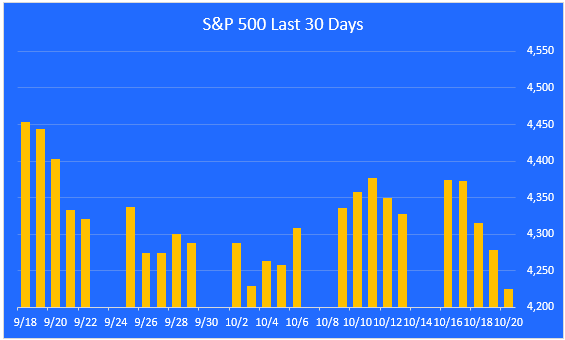
A look at monthly returns.
This chart shows the monthly returns for the past year. October is off to a negative start, after losing ground in August and September.
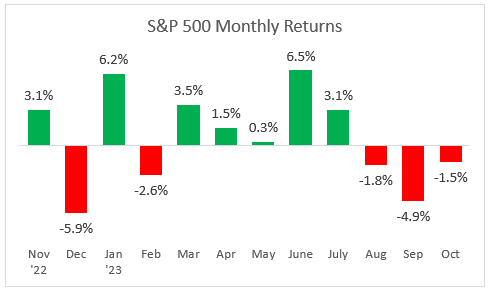
The bull market is well below the trend line.
This chart highlights the 18.1% gain in the S&P 500 from the October 2022 low through Friday’s close. The index is now 11.9% below its record-high close on January 3, 2022.
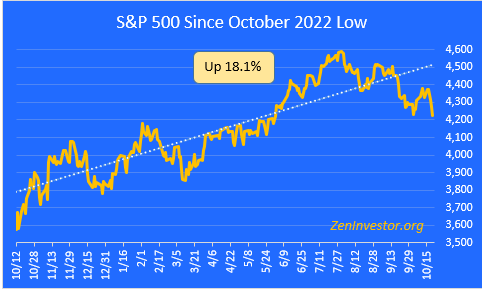
The Golden Cross.
The market entered a Golden Cross configuration (a Golden Cross occurs when the 50-day moving average crosses above the 200 day) on February 2, 2023.
The spread between these two moving averages is beginning to narrow. Today it stands at 3.5%. The long-term average spread is 2.3%.
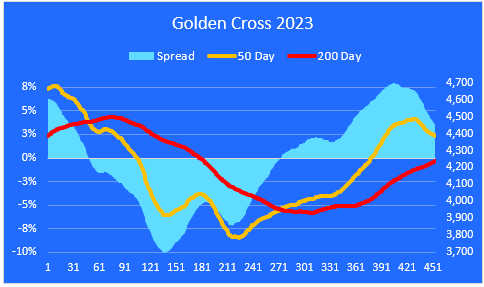
Major asset class performance.
Here is a look at the performance of the major asset classes, sorted by last week’s returns. I also included the year-to-date returns as well as the returns since the October 12, 2022, low for additional context.
The best performer last week was Volatility, as investors were willing to pay higher premiums to hedge their downside risk.
The worst-performing asset class last week was the Asia 50 index, led by continued weakness in the China equity market.
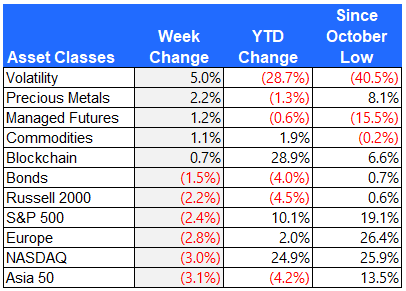
Equity sector performance
For this report I use the expanded sectors as published by Zacks. They use 16 sectors rather than the standard 11. This gives us added granularity as we survey the winners and losers.
Retail, Consumer Staples, and Energy stocks held up the best last week.
Autos were the hardest hit, as the strikes continue, and Tesla fell 15% on the week.
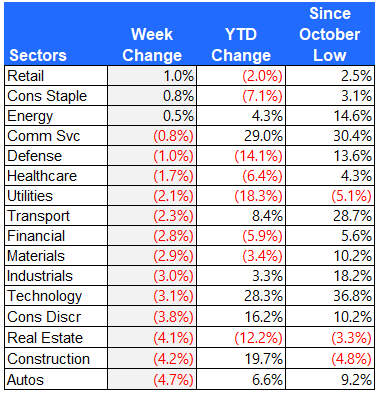
Equity group performance
For the groups, I separate the stocks in the S&P 1500 Composite Index by shared characteristics like growth, value, size, cyclical, defensive, and domestic vs. foreign.
All of the equity groups lost ground last week. The worst-performing group was the S&P top 7 tech stocks. Leadership and participation has narrowed once again, which is not a healthy sign for the market.
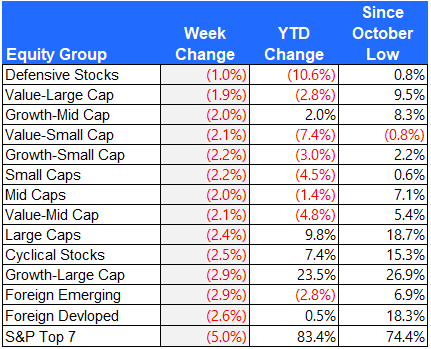
The S&P Top 7
Here is a look at the seven mega-cap stocks that have been leading the market all year. Microsoft (MSFT) held up the best, while Tesla (TSLA) and Nvidia (NVDA) led the way down.
These seven stocks account for 87% of the total YTD gain in the S&P 500. That’s up from 79% just a few weeks ago, providing evidence that participation in the bull market is narrowing once again.
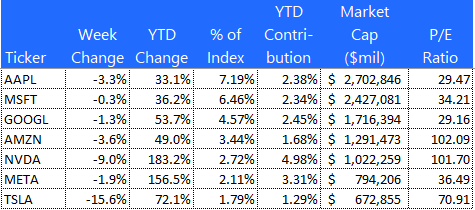
The 10 best-performing ETFs from last week
Bitcoin (BTC-USD) has been rallying this year, but it is still down by 48% from its peak set back in October 2021. Gold and silver rallied as investors sought refuge in safe havens.
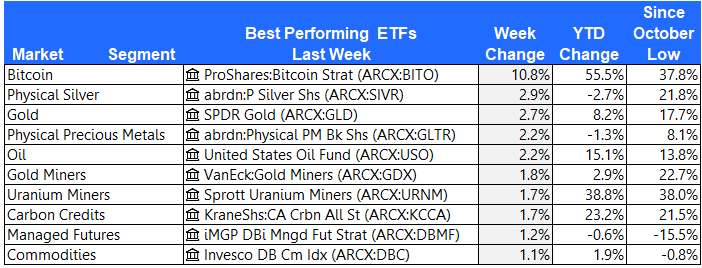
The 10 worst-performing ETFs from last week
Solar energy stocks took a big hit last week as high and rising interest rates are making it more costly to finance solar installations.
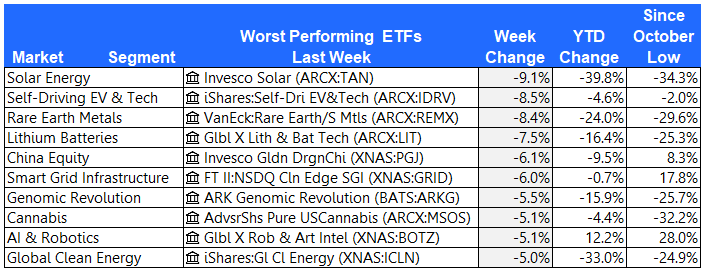
The 10 best-performing stocks from last week
Here are the 10 best-performing stocks in the S&P 1500 last week.
Victoria’s Secret (VSCO) caught a bid after the company announced it was returning to its “sexy” branding image.
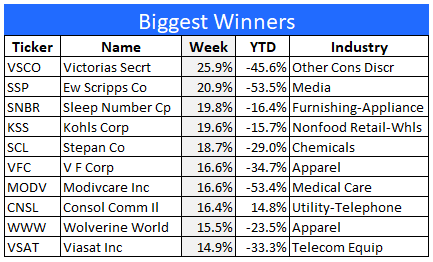
The 10 worst-performing stocks from last week
Here are the 10 worst-performing stocks in the S&P 1500 last week.
SolarEdge (SEDG) and Enphase (ENPH) sold off hard, as demand for solar installations continues to be depressed by higher interest rates.
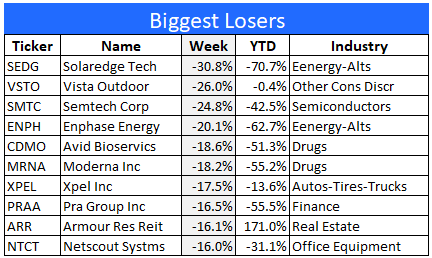
Final thoughts
The S&P Top 7 stocks continue to dominate the market. As the following chart shows, these seven mega-cap tech stocks account for 87% of the S&P 500 YTD gain.
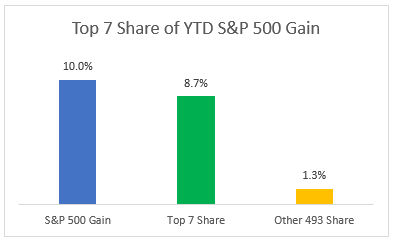
Since the recent market peak on July 31, the S&P 500 is down 7.9% and the Top 7 cohort is down by 7.7%. After several months of broadening market participation, it now looks like leadership is beginning to narrow again.
As this pullback continues to play out, I will be paying close attention to what’s happening with the Top 7. For now, at least, they still call the tune.
Are you looking for more high quality ideas? Consider joining The ZenInvestor Top 7, my Marketplace service. The Top 7 is a factor-based trading strategy. Its screening algorithm prioritizes reasonable price first, then the momentum, and finally projected earnings growth. The strategy produces 5-7 names, and rebalances every 4 weeks (13 times per year). The goal is to catch healthy companies that have gone through a rough period, and are now showing signs of making a strong comeback. Join now with a two-week free trial.
Editor’s Note: The summary bullets for this article were chosen by Seeking Alpha editors.



